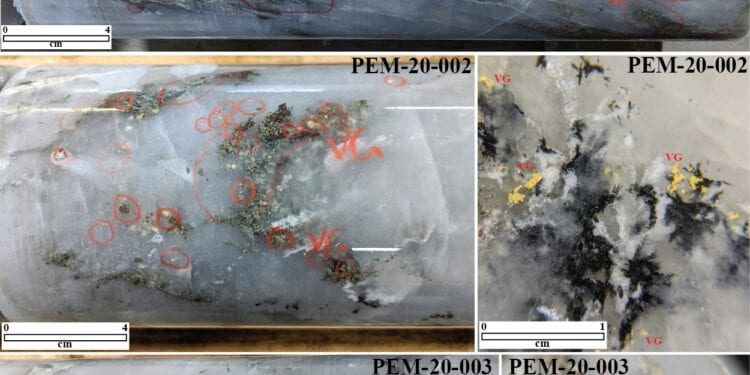Company Confident Of High Recoveries From Head Grades
Amex Exploration Inc. (TSXV:AMX) has intersected high-grade head grades from three metallurgy holes at High Grade Gold Zone of the Eastern Gold Zone (EGZ) at the Perron Project in Canada.
The holes were specifically drilled into three different Metal Factor isocontour areas of the High Grade Gold Zone
Results included:
- Hole PEM-20-001intersected 11.80m of 27.70 g/t Au for a metal factor (MF) of 326.86 gram metres of gold. This metallurgical test hole is located approximately six metres East of the previously drilled hole PE-17-03 that returned a MF of 59.09 gram metres of gold.
- Hole PEM-20-002 intersected 16.60m of 12.70 g/t Au for a MF of 210.82 gram metres of gold. This drill hole is located within the >100 gram meter gold isocontour which validates the high grade continuity of the system.
- Hole PEM-20-003 returned 10.60 m of 5.65 g/t Au for a MF of 59.89. This hole is located inside an area previously identified with a MF isocontour of 10 to 50 gram meters of gold.
These metallurgy holes were drilled using large diameter PQ size drill holes to provide enough material for proper and representative testing.
Executive Chairman, Jacques Trottier, said the samples are now being processed and tested for recovery rates which the company anticipates will be quite high given the ore mineral assemblage of free visible gold, with a low percentage of sulphides including dominantly sphalerite and lesser pyrite.
The metallurgical drill holes were drilled in areas of the upper near-surface portion of the High Grade Zone (HGZ) that were anticipated to provide representative high, medium, and low grade samples.
The bulk samples included the hanging wall and footwall veins, as well as the weakly mineralised interior mafic dyke rock, with the objective of testing representative mining widths across the entirety of the HGZ. The results, both on a visual level and with the head grade results, exceeded expectations.
Mr Trottier said that of interest is the significant increase of visible gold grains and associated high grade mineralization in holes PEM-20-001 and PEM-20-003, which indicates that larger diameter drilling may be related to an increase in grade.
“There are several important things that we have illustrated with the drilling of these larger diameter PQ holes,” he said.
“First, when reviewing the longitudinal, the larger diameter drilling demonstrates mineralization is richer than previous drill holes indicated, given that two of the three holes returned a higher metal factor than was previously indicated for their location. This is common with very high-grade Archean gold mines, where the mined head feed ore sent to the mill is often richer than indicated by core drilling intersects that were used in resource calculations.”
“Second, we are seeing tremendous vertical continuity and homogeneity of the very high-grade zone with coarse gold grains. These large diameter holes are very useful in validating true high grade mineralisation values.
“Finally, we believe the recovery rate is going to be very significant by simple gravity separation process given the amount of free gold in the samples. I am keen to see the recovery rates following the next phases of the ongoing metallurgy test programme.”











